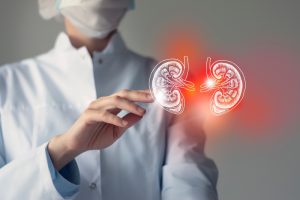


Welcome to Electrolyte Abnormalities Treatment clinic in Dubai at Emirates Hospitals Group. Electrolyte abnormalities refer to imbalances in the levels of essential minerals in the blood, including sodium, potassium, calcium, magnesium, and phosphate. These electrolytes play crucial roles in maintaining various bodily functions, such as fluid balance, nerve function, and muscle contraction.
At Emirates Hospitals Group, our Nephrology Department provides specialized care for managing electrolyte abnormalities to ensure overall health and prevent serious complications.
Sodium and Electrolyte Imbalance
- Sodium helps regulate fluid balance, blood pressure, and nerve and muscle function.
- An imbalance in sodium levels can lead to:
- Hyponatremia (low sodium): This condition occurs when the sodium level in the blood is too low. It can result from excessive water intake, kidney problems, or heart failure. Symptoms of hyponatremia include swelling, headache, confusion, nausea, and, in severe cases, seizures or coma.
- Hypernatremia (high sodium): This condition occurs when there is too much sodium in the blood, often due to dehydration or excessive salt intake. It can lead to symptoms like thirst, dry mouth, lethargy, confusion, and even seizures in extreme cases.

Potassium and Electrolyte Imbalance
- Potassium is crucial for proper cell function, particularly in muscle contractions, including the heart. It helps in maintaining normal heart rhythm and nerve function.
- An imbalance in potassium levels can cause serious health problems:
- Hypokalemia (low potassium): Low potassium levels are often caused by excessive loss through vomiting, diarrhea, or diuretic use. Symptoms include muscle weakness, cramps, fatigue, irregular heartbeat, and, in severe cases, paralysis.
- Hyperkalemia (high potassium): High potassium levels can occur due to kidney dysfunction, certain medications, or excessive potassium intake. Symptoms of hyperkalemia include weakness, fatigue, heart palpitations, and in severe cases, cardiac arrest.
Relation Between Sodium and Potassium
Sodium and potassium work together to maintain the balance of fluids inside and outside of cells. This balance is essential for proper nerve and muscle function, as well as fluid distribution in the body. The sodium-potassium pump is a vital mechanism that actively transports sodium out of cells and potassium into cells, ensuring that the right amounts are present in the extracellular and intracellular spaces. Disruption in the balance of these two electrolytes can have significant impacts on overall health, especially affecting heart and muscle function.

Treatment and Management
Managing electrolyte abnormalities related to sodium and potassium involves:
- Dietary adjustments: Ensuring balanced intake of sodium and potassium-rich foods, such as bananas, oranges, spinach, and potatoes.
- Medications: Potassium supplements or diuretics may be used to correct imbalances.
- Intravenous fluids: In cases of severe imbalance, fluids may be administered through an IV to restore normal levels.
- Dialysis: For kidney-related electrolyte imbalances, dialysis may be required to filter excess potassium or sodium from the blood.
If you suspect an electrolyte imbalance, especially involving sodium or potassium, it is important to seek medical care to prevent complications. The Nephrology Department at Emirates Hospitals Group is equipped to diagnose and manage electrolyte abnormalities with comprehensive care and tailored treatment plans.
Causes of Electrolyte Abnormalities
Electrolyte imbalances can occur for a variety of reasons, including:
- Kidney Dysfunction: Impaired kidney function can disrupt the regulation of electrolytes.
- Medications: Certain drugs, such as diuretics, can lead to imbalances in electrolytes.
- Dehydration: Severe dehydration can lead to an imbalance of sodium, potassium, and other electrolytes.
- Hormonal Disorders: Conditions such as adrenal insufficiency or thyroid disorders can affect electrolyte levels.
- Chronic Conditions: Diabetes, heart disease, and other chronic conditions may impact electrolyte balance.
- Dietary Deficiencies: Inadequate intake of key nutrients can also cause imbalances.
Symptoms of Electrolyte Abnormalities
Symptoms may vary depending on the type of imbalance, but common signs include:
- Muscle weakness or cramps
- Fatigue or lethargy
- Irregular heartbeats
- Nausea or vomiting
- Confusion or changes in mental status
- Swelling or edema
- Shortness of breath
- Seizures (in severe cases)

Diagnosis of Electrolyte Abnormalities
At Emirates Hospitals Group, we provide comprehensive diagnostic services to identify the underlying cause of electrolyte imbalances:
- Blood Tests: To measure levels of key electrolytes like sodium, potassium, calcium, and magnesium.
- Urine Tests: To assess how well the kidneys are excreting electrolytes.
- Kidney Function Tests: Including creatinine and glomerular filtration rate (GFR) to evaluate kidney health.
- Electrocardiogram (ECG): To check for any abnormal heart rhythms related to electrolyte imbalances.
Treatment for Electrolyte Abnormalities
Treatments at Emirates Hospitals Group is tailored to the specific type of imbalance and its underlying cause. Key treatments include:
- Intravenous Fluids: To restore proper fluid and electrolyte levels.
- Medications: To correct imbalances, such as potassium or calcium supplements, or medications to address kidney or hormonal conditions.
- Dialysis: In severe cases of kidney dysfunction, dialysis may be required to remove excess electrolytes.
- Dietary Modifications: Our nutritionists provide personalized guidance to adjust your diet for better electrolyte balance.
- Lifestyle Adjustments: Recommendations for hydration, exercise, and medications to maintain healthy electrolyte levels.
Prevention and Management
Maintaining a healthy lifestyle is key to preventing electrolyte abnormalities. At Emirates Hospitals Group, we offer ongoing monitoring and support to help patients manage their condition effectively, including:
- Regular check-ups for those with chronic conditions like kidney disease, diabetes, or heart disease.
- Guidance on fluid intake and electrolyte-rich diets.
- Personalized care plans to monitor electrolyte levels and adjust treatment accordingly.
Frequently Asked Questions
The most common electrolyte abnormalities are sodium imbalances (specifically hyponatremia and hypernatremia) and potassium imbalances (particularly hypokalemia and hyperkalemia). These two electrolytes play critical roles in maintaining fluid balance, nerve function, and muscle contraction, and imbalances can result from dehydration, kidney dysfunction, or medications.
Electrolyte imbalances can lead to a wide range of symptoms depending on the specific electrolyte involved. Common symptoms include:
- Fatigue: Feeling weak or excessively tired due to the impact on muscle and nerve function.
- Muscle Cramps or Weakness: Potassium, calcium, and magnesium imbalances can cause muscle spasms or weakness.
- Heart Palpitations: Imbalances, especially in potassium, can cause irregular heart rhythms (arrhythmias).
- Confusion or Mental Fog: Sodium imbalances (especially low sodium) can affect cognitive function and lead to confusion or disorientation.
- Swelling: Sodium imbalance, particularly in cases of hyponatremia, can lead to fluid retention and swelling, especially in the legs and feet.
Yes, an electrolyte imbalance can contribute to feelings of anxiety. Low levels of magnesium and calcium can disrupt nerve function and lead to heightened stress responses in the body. Additionally, imbalances in sodium or potassium can affect brain function and cause symptoms like nervousness, restlessness, and anxiety.
An electrolyte abnormality blood test is a diagnostic tool used to measure the levels of various electrolytes in the blood, including sodium, potassium, calcium, bicarbonate, chloride, and magnesium. The test helps identify any imbalances that could be affecting body functions such as muscle contractions, heart rhythms, and fluid balance. The results of this test can help healthcare providers determine the cause of symptoms like fatigue, weakness, irregular heartbeat, and confusion, and guide treatment options accordingly.
At Emirates Hospitals Group, our Nephrology Department offers comprehensive diagnosis and management of electrolyte imbalances through blood tests and personalized treatment plans. If you’re experiencing symptoms of an electrolyte imbalance, it’s essential to seek expert care.
Request an appointment
Please complete the details and we will book you shortly.
Request an appointment
Please complete the details and we will book you shortly.
